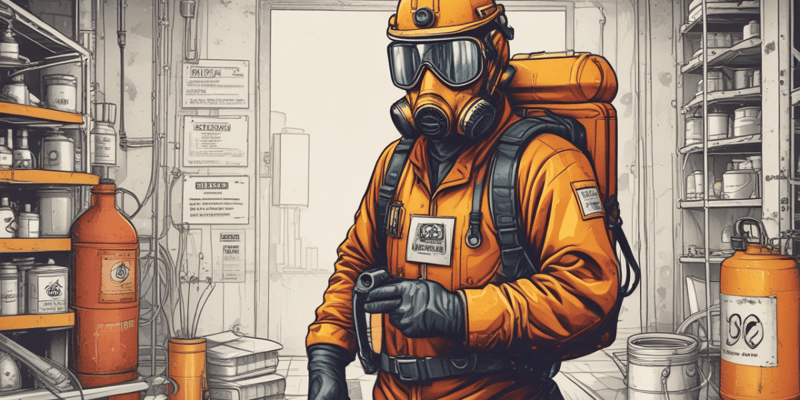Podcast Beta
Questions and Answers
What describes acute exposure?
Which term refers to a list of all substances that contain chemicals in an office?
What is the purpose of the Globally Harmonized System of Classification and Labeling of Chemicals (GHS)?
Which statement correctly defines a health hazard?
Signup and view all the answers
What does a hazard classification provide?
Signup and view all the answers
Which type of waste is identified as infectious waste?
Signup and view all the answers
What does a precautionary statement indicate regarding chemicals?
Signup and view all the answers
Which label elements help identify specific hazard classes?
Signup and view all the answers
What are oxidizers in terms of chemical classification?
Signup and view all the answers
What is true about flammable materials?
Signup and view all the answers
Study Notes
Chemical Hazards
- Hazard class: a classification that provides a number or name of hazardous properties that present a potential hazard to human health and safety.
- Hazard classification: a systematic standardized statement that divides health and physical hazards into separate classifications.
- Hazard statement: a statement assigned to a hazard class and category that describes the nature of the hazard(s) of a chemical, including, where appropriate, the degree of hazard.
- GHS (Globally Harmonized System of Classification and Labeling of Chemicals): an organization that defines and classifies the hazards of chemical products and communicates health and safety information on labels and Safety Data Sheets (SDS).
- Label elements: the pictogram, hazard statement, signal word, and precautionary statement for each hazard class and category.
- Pictograms: graphic elements used on a hazard label to identify the specific hazard class and category.
- Product identifier: name or number used for a hazardous chemical on a label or in the Safety Data Sheet (SDS).
- Signal word: two words used on the SDS: “Warning” for less severe hazard categories and “Danger” for more severe hazard categories.
- Precautionary statement: a phrase that describes recommended measures to take to minimize or prevent adverse effects from exposure to a hazardous chemical or the improper storage or handling of a hazardous chemical.
Types of Chemical Hazards
- Flammable: materials that are readily capable of catching fire.
- Physical hazard: a chemical that can be a combustible liquid, a compressed gas, an explosive material, flammable-reactive, or water-reactive and is a health hazard.
- Health hazard: a chemical, physical or biological exposure that can affect an employee’s short or long term health.
- Toxic chemicals: chemicals that can have a fatal or toxic effect to humans.
- Oxidizers: a type of chemical that will react or cause a chemical to react with oxygen causing a severe fire hazard.
Chemical Exposure
- Acute exposure: high levels of exposure over a short period.
- Chronic exposure: continuous or repeated contact with a substance over a long period.
Chemical Waste
- Contaminated waste: waste that is contaminated from a potentially infectious body fluid of a patient.
- Hazardous waste: waste that poses a risk to humans or to the environment if discarded into landfill or poured down the drain.
- Infectious waste: waste that includes biologic materials capable of transmitting an infectious disease.
- Toxic waste: waste that can have a toxic effect to humans.
- Regulated waste: items that have been deemed to pose a risk to humans or the environment and for which disposal is regulated by the state for medical waste and the Environmental Protection Agency (EPA) for chemical waste.
Information Resources
- Chemical inventory: a list of all substances used in the office that contain chemicals.
- Safety Data Sheet (SDS): a form provided by the chemical manufacturer that provides printed information regarding the hazards of materials and products that contain chemicals.
Studying That Suits You
Use AI to generate personalized quizzes and flashcards to suit your learning preferences.
Description
This quiz covers the essential concepts related to chemical hazards, including classification, hazard statements, and the Globally Harmonized System (GHS). Understand how labels and pictograms communicate health and safety information regarding chemicals. Test your knowledge on the various classifications and elements involved in chemical hazard communication.




